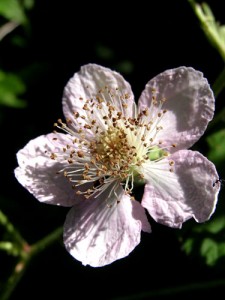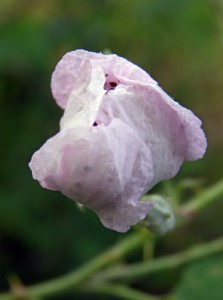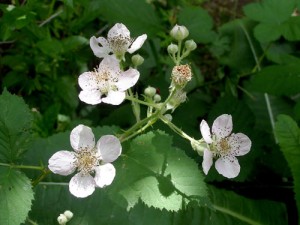Himalaya-berry, as pretty as any rose

Single flower of Himalaya-berry is worth a search in your wild garden and along roadsides. Photo by Ken Moore.
By Ken Moore
You may remember the description in this column three weeks ago of the common wild blackberry, Rubus argutus, in full flower during our traditional blackberry winter. Coming into full flower this week is another one of those wild blackberries. This one, Rubus discolor, Himalaya-berry, bears a flowering branch of quarter-to-half-dollar-size, single-petaled, pale-pink flowers, as pretty as any rose, and it’s running loose in and around Carrboro. It is an “alien blackberry†because it was introduced from Europe long ago.
I know some of you are already thinking, “Oh, no; here comes another tirade about exotic invasives!†Surprise; I’m not concerned about this one. It can’t come close to competing with the aggressive true native blackberries. This one is uncommon and worth a search in your wild garden and along roadsides and field edges in your neighborhood.
Keep your eyes alert for arching, thorny blackberry stems. The Himalaya-berry is not as densely flowering as the common ones. The white-to-pink flowers are borne on more loosely branching flowering stems. The undersides of the leaves are white and pubescent (fuzzy to the touch) in contrast to leaves of the common blackberries, which are green on both surfaces. While you’re looking, notice that the leaves of the flowering branches, floricanes, have three leaflets and the leaves of the non-flowering stems, primocanes, have five leaflets, characteristic of all blackberries. Blackberry flowers and fruit are produced on the second-year stems (canes).
I have a few of these Himalaya-berries along the edge of my driveway. A few days ago, I was happy to see them begin flowering. I’ve been taking “closer looks†several times each day since. This year, I’m particularly taken by the beauty of each individual flower.
Each one appears to be a delicately pink-shaded rose, and that’s logical, since blackberries are in the rose family.
Very early one recent, misty morning, I went out to enjoy my stems of “miniature roses†and discovered they were all tightly closed. I know that some flowers regularly close up during the night, but I have never noticed this habit in blackberries. Now I know these flowers open and close regularly in response to the sunlight of day. What a natural way this may be to protect mature pollen from being washed away by night-time dew and sunless daytime rains. Now I’m more curious about the flowers of plants that don’t have the opening-closing habit, like the flowers of hollies. I remember an old friend explaining that long rainy periods during the spring may result in a sparse crop of holly berries in the fall. That makes sense: no pollen, no pollination. In addition, you don’t see many pollinators flying about in the rain. No pollinators, no pollination.

Closed flowers open on sunny days to reveal beautiful rose-like flowers on a stem of Himalaya-berry. Photo by Ken Moore.
I’m looking forward to the Himalaya-berry bearing fruit a few weeks after the traditional Fourth of July blackberry-picking time. I remember tasting the superior sweetness of this foreign berry some years ago. It’s well worth cultivating in the garden, where it can be well tended and trained along a trellis.
Good luck with your search, and along the way I suspect your keen eyes will make a few other discoveries.



Comments are closed.